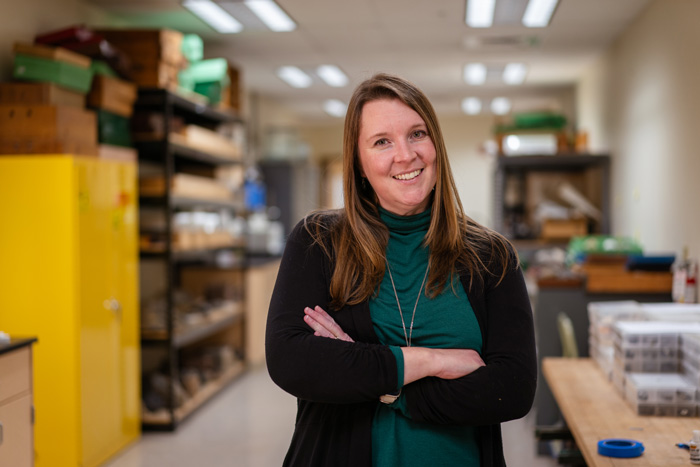The Geosciences: Look No Further Than Everywhere

Jorden Hayes in a lab in Kaufman Hall, home of the Department of Geosciences. Photo by Dan Loh.
OFFICE HOURS: Jorden Hayes, Assistant Professor of Geosciences
by Tony Moore
Assistant Professor of Geosciences Jorden Hayes earned her Ph.D. at the University of Wyoming. Her current projects include the Bedrock Critical Zone Network, GNOMES (Geophysics of the Near-surface: an Outdoor Motivational Experience for Students) and multiple projects undertaken in central Pennsylvania. She teaches such courses as Earth’s Hazards and Oceanography.
You and your students trek to remote parts of the globe (and state) hoping to unlock secrets of where the Earth is going by studying where it’s been. What makes Dickinson a great place for this sort of endeavor?
We have a strong focus on experiential learning and are fortunate to have generous alumni who have supported geosciences through the Cassa Fund and the newly established Arctic & Alpine Program. Our students have traveled to the Canadian Arctic, Chile, Peru, the Sierra Nevada, southern Appalachians, Rockies and more.
Geosciences at Dickinson also helps students practice their knowledge as engaged citizens within the local community. For example, my Environmental Geophysics classes regularly participate in community-based projects, such as assisting the Mt. Tabor Preservation Project helping people reclaim their history by using ground-penetrating radar to identify unmarked burials. This demonstrates the important role that scientists have in shaping a more sustainable and equitable future.
Your faculty page says you’re a critical-zone scientist interested in the transformation of rock at depth into a habitable substrate for life at the surface. I can imagine exactly what that means and also can’t imagine it at all. Can you unpack it a little and explain how this became your specialty?
Indeed! The critical zone is the thin, life-sustaining skin of our planet that extends from treetop to bedrock. It is a remarkably interconnected system. To better understand this part of our planet, I use geophysics. Geophysical imaging is a bit like giving the planet an ultrasound or MRI, but instead of looking at how blood flows through the human body, I try to understand how water moves through the ground. Doing this helps us answer questions about how pathways for water form as rocks break down and fracture.
I didn’t start my studies with the critical zone; instead, I started graduate school in marine tectonics, wanting to know how continents form from volcanoes. Though this is only the abbreviated version of my science journey, if I were to distill one key takeaway it would be that the path forward is frequently meandering, yet time spent learning is never wasted.
The geosciences cover a lot of ground (literally; sorry): the atmosphere, oceans, soils, organisms, solid earth. If the Earth piled all of this together and wrote an autobiography, what would it say about itself and its prospects going forward?
This is the heart of what geoscientists do: We uncover the past to help predict the future and better inform decisions for today. If Earth were to pen its autobiography, it would undoubtedly be a captivating tale of resilience, transformation and interconnectedness. There would be stories of mountains and valleys, plains and deserts, glaciers and rivers among the multitude of processes that sculpted the planet’s surface. There would be drama in the evolution of life from single-celled organism to complex ecosystem. The precariousness of life would be underscored in extinction events punctuating the planet’s 4.5-billion-year history.
As the story progresses, Earth might highlight the delicate balance between atmosphere, biosphere and geosphere that has emerged over eons, sharing struggles as these systems adapt to external pressures. Yet, in the face of these challenges, Earth’s story would also be one of resilience and adaptability. It would narrate tales of positive change in the modern age: repair of the ozone, ecosystems rebounding and the potential for continued positive change. Earth’s story would likely end with a plea for responsible stewardship and urging toward more sustainable practices on our planetary home, which geosciences give us some of the best tools to address.
TAKE THE NEXT STEPS
Published March 4, 2024